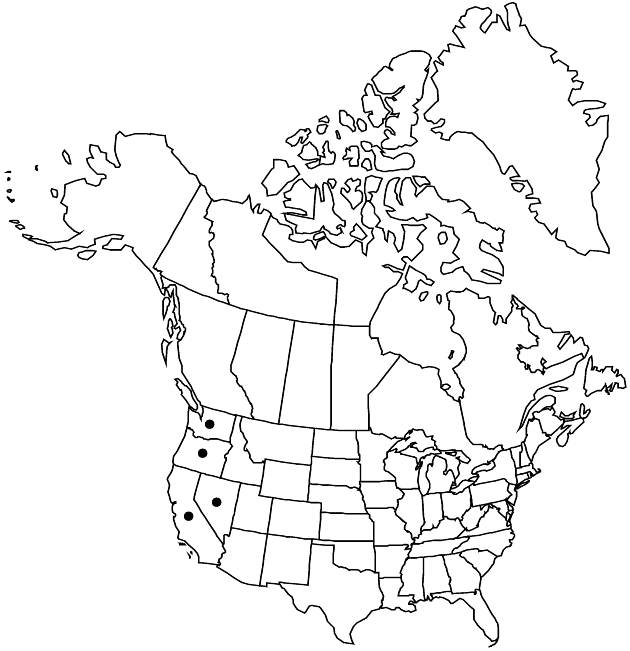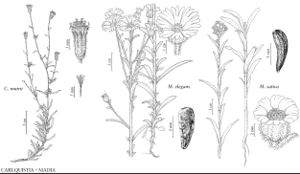Difference between revisions of "Madia elegans"
Edwards’s Bot. Reg. 17: plate 1458. 1831.
FNA>Volume Importer |
FNA>Volume Importer |
||
| Line 12: | Line 12: | ||
|name=Madia elegans subsp. densifolia | |name=Madia elegans subsp. densifolia | ||
|authority=(Greene) D. D. Keck | |authority=(Greene) D. D. Keck | ||
| + | |rank=subspecies | ||
}} {{Treatment/ID/Synonym | }} {{Treatment/ID/Synonym | ||
|name=Madia elegans subsp. vernalis | |name=Madia elegans subsp. vernalis | ||
|authority=D. D. Keck | |authority=D. D. Keck | ||
| + | |rank=subspecies | ||
}} {{Treatment/ID/Synonym | }} {{Treatment/ID/Synonym | ||
|name=Madia elegans subsp. wheeleri | |name=Madia elegans subsp. wheeleri | ||
|authority=(A. Gray) D. D. Keck | |authority=(A. Gray) D. D. Keck | ||
| + | |rank=subspecies | ||
}} | }} | ||
|hierarchy=Asteraceae;Asteraceae tribe Heliantheae;Asteraceae (tribe Heliantheae) subtribe Madiinae;Madia;Madia elegans | |hierarchy=Asteraceae;Asteraceae tribe Heliantheae;Asteraceae (tribe Heliantheae) subtribe Madiinae;Madia;Madia elegans | ||
| Line 42: | Line 45: | ||
-->{{#Taxon: | -->{{#Taxon: | ||
name=Madia elegans | name=Madia elegans | ||
| − | |||
|authority=D. Don ex Lindley | |authority=D. Don ex Lindley | ||
|rank=species | |rank=species | ||
| Line 57: | Line 59: | ||
|publication year=1831 | |publication year=1831 | ||
|special status= | |special status= | ||
| − | |source xml=https://jpend@bitbucket.org/aafc-mbb/fna-data-curation.git/src/ | + | |source xml=https://jpend@bitbucket.org/aafc-mbb/fna-data-curation.git/src/eaa6e58056e40c9ef614d8f47aea294977a1a5e9/coarse_grained_fna_xml/V19-20-21/V21_747.xml |
|tribe=Asteraceae tribe Heliantheae | |tribe=Asteraceae tribe Heliantheae | ||
|subtribe=Asteraceae (tribe Heliantheae) subtribe Madiinae | |subtribe=Asteraceae (tribe Heliantheae) subtribe Madiinae | ||
Revision as of 19:38, 16 December 2019
Plants 6–250 cm, self-incompatible (heads showy). Stems proximally villous to hirsute, distally glandular-pubescent, glands yellowish, purple, or black, lateral branches sometimes surpassing main stems. Leaf blades lanceolate to linear, 3–20 cm × 2–20 mm. Heads in open, corymbiform arrays. Involucres ± globose to campanulate, 4.5–12 mm. Phyllaries ± hirsute or villous, usually glandular-pubescent as well, glands yellowish, purple, or black, apices erect or reflexed, flat. Paleae mostly persistent, mostly connate 1/2+ their lengths. Ray florets (2–)5–22; corollas bright yellow (sometimes with maroon bases), laminae 4–20 mm. Disc florets 25–80+, functionally staminate; corollas 2.5–5 mm, pubescent; anthers yellow to brownish or ± dark purple. Ray cypselae black or brown, sometimes mottled, dull, compressed or ± 3-angled (slightly rounded abaxially, angled 15–45° adaxially), beakless (or nearly so). Disc cypselae 0. 2n = 16.
Phenology: Flowering Apr–Nov.
Habitat: Grasslands, meadows, open sites in shrublands, woodlands, and forests, disturbed sites, often in coarse or clayey soils, sometimes serpentine
Elevation: 0–3400 m
Distribution

Calif., Nev., Oreg., Wash., Mexico (Baja California).
Discussion
Madia elegans occurs widely in California outside the deserts and in southwestern Oregon and locally in western Nevada and Washington. It is unusually variable in morphology, ecology, and phenology. Molecular data have indicated that D. D. Keck’s (1959) infraspecific taxonomy for M. elegans needs revision. Putative natural (sterile) hybrids with M. sativa have been collected (e.g., D. D. Keck 2647, UC, from northern California).
Selected References
None.
